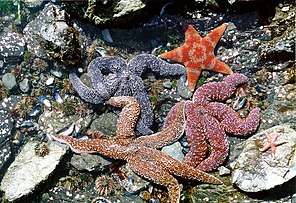Ambulacraria
Ambulacraria, or Coelomopora, is a clade of invertebrate phyla that includes echinoderms and hemichordates;[1] a member of this group is called an ambulacrarian. Phylogenetic analysis suggests the echinoderms and hemichordates separated around 533 million years ago.[2] The Ambulacraria are part of the deuterostomes, a larger clade that also includes the Chordata, Vetulicolia and Saccorhytus.
| Ambulacrarians Temporal range: Early Cambrian – Recent | |
|---|---|
 | |
| Various sea stars and sea urchins among mussel shells in the rocky intertidal zone of Kachemak Bay, southern Alaska, United States | |
| Scientific classification | |
| Kingdom: | Animalia |
| Subkingdom: | Eumetazoa |
| Clade: | ParaHoxozoa |
| Clade: | Bilateria |
| Clade: | Nephrozoa |
| Superphylum: | Deuterostomia |
| Clade: | Ambulacraria Metschnikoff, 1881 |
| Phyla | |
| |
The two living clades with representative organisms are:
- Echinodermata (sea stars, sea urchins, brittle stars, sea cucumbers, feather stars, sea lilies, etc.)
- Hemichordata (acorn worms, Pterobranchia, and possibly graptolites)
(These together sometimes are called the lower deuterostomes.[3])
The group Xenoturbellida (two species of worm-like animals) had previously been considered to be in this clade but is now considered to be placed more basally among metazoans.[4]
Fossil taxa that may lie on the stem lineage:
- Superphylum Ambulacraria
- unranked clade Cambroernida
- † unranked clade = Eldoniida
- † Stellostomites Caron, Conway Morris & Shu, 2010[5]
- † Velumbrella?
- † Herpetogaster Caron, Conway Morris & Shu, 2010[5] - with one species: † Herpetogaster collinsi Caron, Conway Morris & Shu, 2010[5]
- † Rotadisciidae
- † unranked clade = Eldoniida
- unranked clade Cambroernida
Ontogeny
As for many animals, the egg cell of any extant ambulacrarian by cell division evolves to a blastula ("cell ball"), which evolves to a triploblast ("three-layered") gastrula. The gastrula then evolves to a dipleurula larva form, which is specific for the ambulacraria.[3] This, in its turn, is developed in various different kinds of larvae for different taxa of ambulacrarians.
It has been suggested that the adult form of the last common ancestor of the ambulacrarians was anatomically similar to the dipleurula larvae, whence this hypothetic ancestor sometimes also is called dipleurula.[7]
References
- Cannon, Johanna Taylor; Vellutini, Bruno Cossermelli; Smith, Julian; Ronquist, Fredrik; Jondelius, Ulf; Hejnol, Andreas (2016). "Xenacoelomorpha is the sister group to Nephrozoa". Nature. 530 (7588): 89–93. Bibcode:2016Natur.530...89C. doi:10.1038/nature16520. PMID 26842059.
- Sea Cucumber Genome Imparts Insight on Genes Linked to Organ Regeneration
- Lacalli, Thurston Castle. "Tutorial". Marine Invertebrate larvae: A study in morphological diversity. University of Saskatchewan. Retrieved 2020-01-13.
- Edgecombe, Gregory D.; Giribet, Gonzalo; Dunn, Casey W.; Hejnol, Andreas; Kristensen, Reinhardt M.; Neves, Ricardo C.; Rouse, Greg W.; Worsaae, Katrine; Sørensen, Martin V. (June 2011). "Higher-level metazoan relationships: recent progress and remaining questions". Organisms, Diversity & Evolution. 11 (2): 151–172. doi:10.1007/s13127-011-0044-4.
- Caron, J.; Conway Morris, S.; Shu, D. (2010). "Tentaculate fossils from the Cambrian of Canada (British Columbia) and China (Yunnan) interpreted as primitive deuterostomes". PLOS One. 5 (3): e9586. Bibcode:2010PLoSO...5.9586C. doi:10.1371/journal.pone.0009586. PMC 2833208. PMID 20221405.
- Murray, J.; MacGabhann, B. A. (2010). "Non-mineralised discoidal fossils from the Ordovician Bardahessiagh Formation, Co. Tyrone, Ireland". Irish Journal of Earth Sciences. 28: 1–12. doi:10.3318/IJES.2010.28.1.
- "Dipleurula". Lexikon der Biologie (in German). Spektrum Akademischer Verlag. Heidelberg. 1999. Retrieved 2020-01-13.